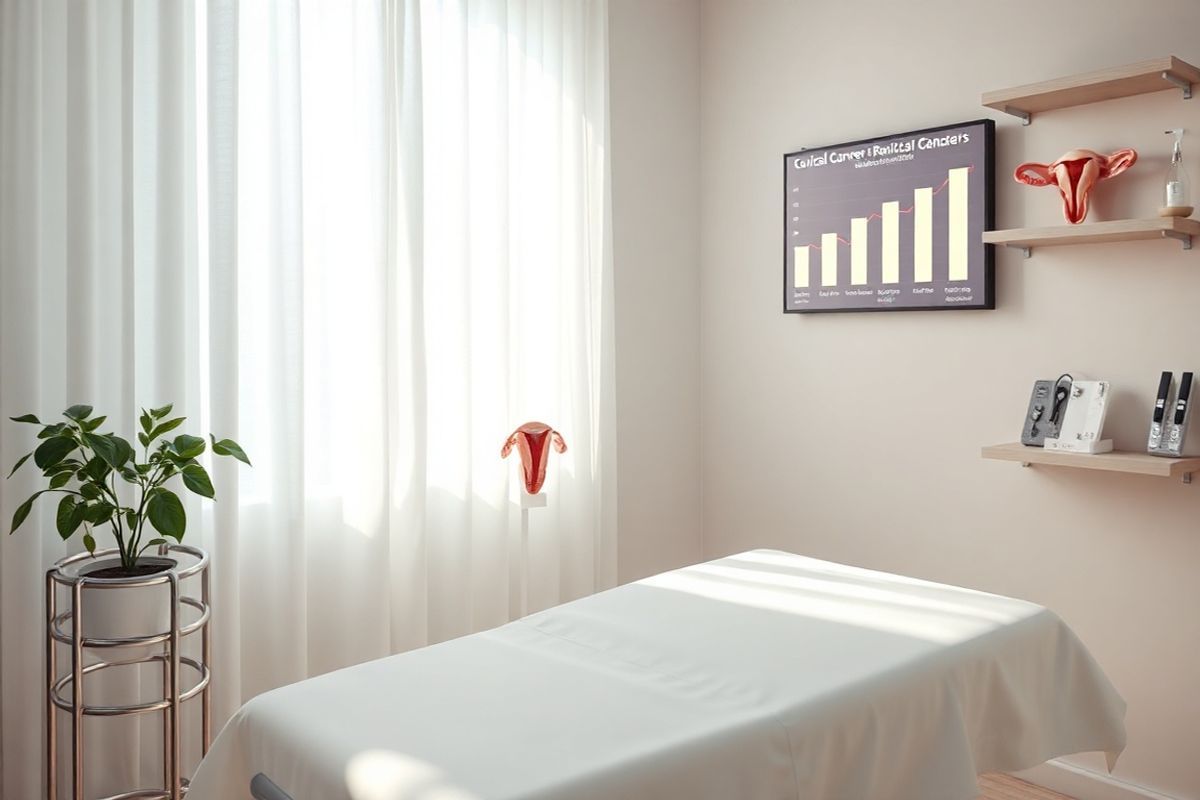Table of Contents
Understanding Cervical Cancer: Causes and Risk Factors

cervical cancer primarily arises from persistent infection with high-risk types of human papillomavirus (hpv). The link between HPV infection and cervical cancer is well-established, as nearly all cervical cancers are associated with HPV (World Health Organization, 2023). Risk factors for developing cervical cancer include:
- Persistent HPV Infection: The primary cause of cervical cancer is a persistent infection with high-risk HPV types, particularly HPV-16 and HPV-18.
- HIV Infection: Women living with HIV are six times more likely to develop cervical cancer than their uninfected counterparts (World Health Organization, 2023).
- Smoking: Tobacco use has been associated with increased risk due to its immunosuppressive effects.
- Long-term Use of Oral Contraceptives: Extended use of hormonal birth control methods may increase risk.
- Multiple Pregnancies: Greater number of births is linked to higher risk due to cervical changes during pregnancy.
- Lack of Screening: Access to regular cervical cancer screening is critical for early detection and prevention.
What is LEEP? A Comprehensive Overview of the Procedure
LEEP is a minimally invasive surgical procedure used to remove abnormal cells from the cervix. It involves using a thin, electrically charged wire loop to excise a portion of cervical tissue containing precancerous cells. The procedure typically occurs in an outpatient setting and is guided by colposcopy, which allows the healthcare provider to visualize the cervix and identify abnormal areas.
Procedure Steps:
- Preparation: The patient lies on an examination table, and a speculum is inserted to allow access to the cervix.
- Local Anesthesia: An anesthetic is administered to minimize discomfort.
- Application of Solution: A vinegar or iodine solution may be applied to enhance visibility of abnormal cells.
- Excision: The wire loop is used to cut away the abnormal tissue.
- Post-Procedure Care: A paste may be applied to control bleeding, and the excised tissue is sent for pathological examination.
Risks of LEEP:
While LEEP is generally safe, potential risks include:
- Heavy bleeding
- Infection
- Scarring of the cervix
- Shortening of the cervix, which may lead to complications in future pregnancies (Emory University, 2023).
Cervical Cancer Screening: The Role of LEEP in Prevention

Cervical cancer screening is essential for early detection and prevention. The implementation of LEEP provides a dual role in treating precancerous lesions and preventing cervical cancer. Regular screenings, such as Pap tests and HPV testing, are recommended starting at age 21 and continuing based on risk factors and previous results. The integration of LEEP into screening protocols allows for immediate treatment of detected abnormalities, significantly reducing the risk of progression to cancer.
Screening Guidelines:
- Age 21-29: Pap smear every three years.
- Age 30-65: Pap smear combined with HPV testing every five years or Pap smear alone every three years.
- Age 65 and older: Discontinuation of screening may be considered if there is a history of adequate negative screenings.
Post-LEEP Outcomes: Evaluating the Risks of Cervical Cancer
Although LEEP effectively treats precancerous lesions, it is essential to evaluate the risks of residual disease or recurrence of cervical cancer. Studies have shown that approximately 9.2% of patients experience residual or recurrent high-grade cervical lesions within two years following LEEP (Xia et al., 2024).
Key Factors Influencing Post-LEEP Outcomes:
- Intraoperative HPV Testing: Positive intraoperative HPV tests during LEEP have been linked with higher recurrence rates, serving as a critical predictor for residual disease (Xia et al., 2024).
- Cervical Length: Shorter cervical lengths following conization may correlate with adverse pregnancy outcomes and increased risk of cervical cancer (Obut et al., 2023).
- Time from Conization to Pregnancy: Short intervals (less than 14 months) between conization and subsequent pregnancies have been associated with a higher risk of preterm delivery and other complications (Obut et al., 2023).
Long-Term Monitoring: Ensuring Cervical Health After LEEP
Post-procedural follow-up is crucial for monitoring cervical health and managing any potential recurrence or residual lesions. Recommendations for follow-up include:
- Regular HPV Testing: HPV testing should be conducted at 6, 12, and 24 months post-LEEP to assess for persistent infection.
- Follow-up Pap Smears: Follow-up Pap tests should continue at intervals recommended by healthcare providers to ensure any abnormal changes are detected early.
- Patient Education: Patients should be informed about signs and symptoms of cervical cancer, such as unusual bleeding, pelvic pain, or abnormal discharge, prompting timely medical evaluation.
Follow-Up Schedule:
| Time Post-LEEP | Recommended Action |
|---|---|
| 6 months | HPV testing and Pap smear |
| 12 months | HPV testing and Pap smear |
| 24 months | HPV testing and Pap smear |
FAQ
1. What is cervical cancer? Cervical cancer occurs when cells in the cervix grow uncontrollably, often due to persistent HPV infection. Early detection through screening can lead to effective treatment.
2. What is LEEP? LEEP is a procedure that removes abnormal cervical cells using an electrically charged wire loop, often performed after abnormal Pap test results.
3. What are the risks associated with LEEP? Risks include bleeding, infection, scarring, and potential complications in future pregnancies.
4. How often should I get screened for cervical cancer after LEEP? Follow-up screening should occur at 6, 12, and 24 months post-LEEP, as recommended by your healthcare provider.
5. Can I still get cervical cancer after LEEP? Yes, while LEEP reduces the risk of cervical cancer, it does not eliminate it entirely. Regular follow-up and monitoring are essential.
References
- World Health Organization. (2023). Cervical cancer. Retrieved from https://www.who.int/news-room/fact-sheets/detail/cervical-cancer
- Emory University. (2023). LEEP (Loop Electrosurgical Excision Procedure). Retrieved from https://med.emory.edu/departments/gynecology-obstetrics/patient-care/patient-education/leep/index.html
- Xia, W., Dai, X., Hu, Y., Yang, S., Chen, C., Li, X. (2024). Value of intraoperative post-conisation human papillomavirus testing in predicting residual or recurrence after treatment with a loop electrosurgical excision procedure in women with HR-HPV positive and cervical high-grade squamous intraepithelial lesion. BMC Cancer, 24(1). https://doi.org/10.1186/s12885-024-13272-9
- Obut, M., İskender, C. T., Kından, A., Çelik, Ö. Y., Bucak, M., Kayıkçıoğlu, F., Çakır, B. T., Koç, S., Çakır, C., Çelen, Ş., Çağlar, A. T. (2023). Factors affecting obstetric outcomes in patients who underwent cold-knife and loop electrosurgical excision procedure conization due to cervical intraepithelial neoplasia 2 or cervical intraepithelial neoplasia 3. Journal of the Turkish-German gynecological Association. https://doi.org/10.4274/jtgga.galenos.2023.2023-1-15










